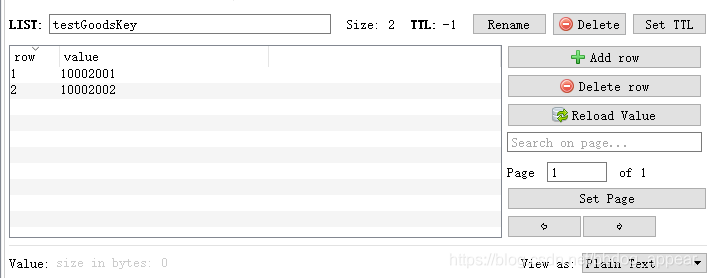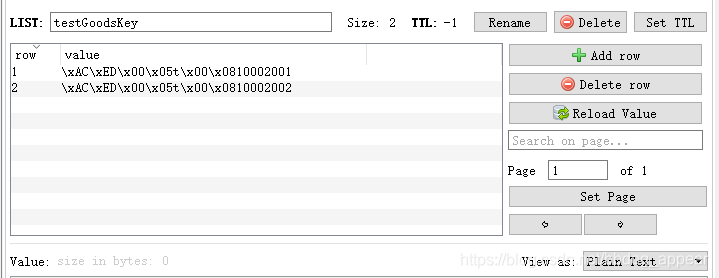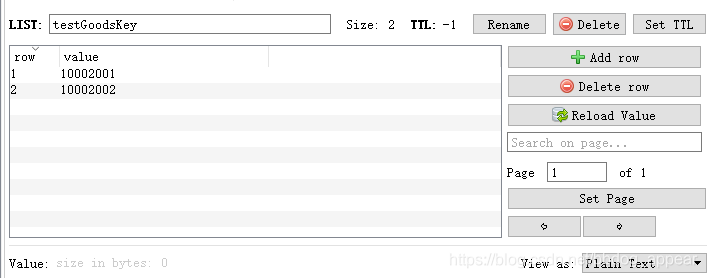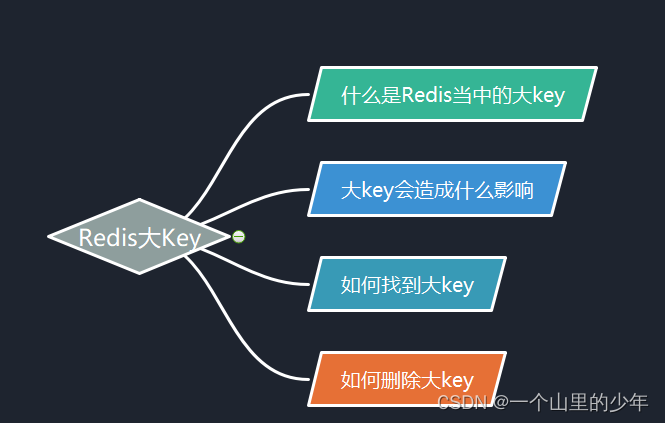RedisTemplate配置序列和反序列化
对于redis操作,springboot进行了很好的封装,那就是spring data redis。提供了一个高度封装的RedisTemplate类来进行一系列redis操作,连接池自动管理;同时将事务封装操作,交由容器进行处理。
针对数据的“序列化和反序列化”,提供了多种策略(RedisSerializer)
默认为使用JdkSerializationRedisSerializer,同时还有StringRedisSerializer,JacksonJsonRedisSerializer,OxmSerializer,GenericFastJsonRedisSerializer。
简介一下
- JdkSerializationRedisSerializer:POJO对象的存取场景,使用JDK本身序列化机制,将pojo类通过ObjectInputStream/ObjectOutputStream进行序列化操作,最终redis-server中将存储字节序列。是目前默认的序列化策略。
- StringRedisSerializer:Key或者value为字符串的场景,根据指定的charset对数据的字节序列编码成string,是“new String(bytes, charset)”和“string.getBytes(charset)”的直接封装。是最轻量级和高效的策略。
- JacksonJsonRedisSerializer:jackson-json工具提供了javabean与json之间的转换能力,可以将pojo实例序列化成json格式存储在redis中,也可以将json格式的数据转换成pojo实例。因为jackson工具在序列化和反序列化时,需要明确指定Class类型,因此此策略封装起来稍微复杂。【需要jackson-mapper-asl工具支持】
- GenericFastJsonRedisSerializer:另一种javabean与json之间的转换,同时也需要指定Class类型。
- OxmSerializer:提供了将javabean与xml之间的转换能力,目前可用的三方支持包括jaxb,apache-xmlbeans;redis存储的数据将是xml工具。不过使用此策略,编程将会有些难度,而且效率最低;不建议使用。【需要spring-oxm模块的支持】
实践
1)依赖(版本继承了SpringBoot版本)
|
1 2 3 4 |
<dependency> <groupId>org.springframework.boot</groupId> <artifactId>spring-boot-starter-data-redis</artifactId> </dependency> |
2)RedisConfig类
添加bean,指定key/value以及HashKey和HashValue的序列化和反序列化为FastJson的。
|
1 2 3 4 5 6 7 8 9 10 11 12 13 14 15 16 17 18 19 20 21 22 23 24 25 26 27 28 29 30 31 |
package com.sleb.springcloud.common.config; import com.alibaba.fastjson.support.spring.GenericFastJsonRedisSerializer; import org.springframework.context.annotation.Bean; import org.springframework.context.annotation.Configuration; import org.springframework.data.redis.connection.RedisConnectionFactory; import org.springframework.data.redis.core.RedisTemplate; import org.springframework.data.redis.serializer.GenericToStringSerializer; /** * redis配置 * @author 追到乌云的尽头找太阳(Jacob) **/ @Configuration public class RedisConfig { @Bean public RedisTemplate<Object, Object> redisTemplate(RedisConnectionFactory redisConnectionFactory) { RedisTemplate<Object, Object> redisTemplate = new RedisTemplate<>(); redisTemplate.setConnectionFactory(redisConnectionFactory); // 使用 GenericFastJsonRedisSerializer 替换默认序列化 GenericFastJsonRedisSerializer genericFastJsonRedisSerializer = new GenericFastJsonRedisSerializer(); // 设置key和value的序列化规则 redisTemplate.setKeySerializer(new GenericToStringSerializer<>(Object.class)); redisTemplate.setValueSerializer(genericFastJsonRedisSerializer); // 设置hashKey和hashValue的序列化规则 redisTemplate.setHashKeySerializer(new GenericToStringSerializer<>(Object.class)); redisTemplate.setHashValueSerializer(genericFastJsonRedisSerializer); // 设置支持事物 redisTemplate.setEnableTransactionSupport(true); redisTemplate.afterPropertiesSet(); return redisTemplate; } } |
RedisTemplate序列化问题
序列化与反序列化规则不一致,导致报错
1、配置redisTemplate
|
1 2 3 4 5 6 7 8 9 10 11 12 13 14 15 16 17 18 19 20 21 22 23 24 25 26 27 28 29 30 31 32 33 34 35 36 37 38 39 40 41 42 43 44 |
<!-- redis数据源 --> <bean id="poolConfig" class="redis.clients.jedis.JedisPoolConfig"> <!-- 最大空闲数 --> <property name="maxIdle" value="${redis.maxIdle}"/> <!-- 最大空连接数 --> <property name="maxTotal" value="${redis.maxTotal}"/> <!-- 最大等待时间 --> <property name="maxWaitMillis" value="${redis.maxWaitMillis}"/> <!-- 返回连接时,检测连接是否成功 --> <property name="testOnBorrow" value="${redis.testOnBorrow}"/> </bean> <!-- Spring-data-redis连接池管理工厂 --> <bean id="jedisConnectionFactory" class="org.springframework.data.redis.connection.jedis.JedisConnectionFactory"> <!-- IP地址 --> <property name="hostName" value="${redis.host}"/> <!-- 端口号 --> <property name="port" value="${redis.port}"/> <!-- 密码 --> <!-- <property name="password" value="${redis.password}"/>--> <!-- 超时时间 默认2000 --> <property name="timeout" value="${redis.timeout}"/> <!-- 连接池配置引用 --> <property name="poolConfig" ref="poolConfig"/> <!-- 是否使用连接池 --> <property name="usePool" value="true"/> <!-- 指定使用的数据库 --> <property name="database" value="0"/> </bean> <!-- redis template definition --> <bean id="redisTemplate" class="org.springframework.data.redis.core.RedisTemplate"> <property name="connectionFactory" ref="jedisConnectionFactory"/> <property name="keySerializer"> <bean class="org.springframework.data.redis.serializer.StringRedisSerializer"/> </property> <property name="valueSerializer"> <bean class="org.springframework.data.redis.serializer.JdkSerializationRedisSerializer"/> </property> <property name="hashKeySerializer"> <bean class="org.springframework.data.redis.serializer.StringRedisSerializer"/> </property> <property name="hashValueSerializer"> <bean class="org.springframework.data.redis.serializer.JdkSerializationRedisSerializer"/> </property> </bean> |
2、存值
此次存值,使用redisTemplate的回调函数,是按照字符串序列化方式存redisValue
|
1 2 3 4 5 6 7 8 9 10 11 12 13 14 |
public void testRedisListPush() { String redisKey = "testGoodsKey"; List<String> redisValues = Arrays.asList("10002001", "10002002"); // 使用管道向redis list结构中批量插入元素 redisTemplate.executePipelined((RedisConnection redisConnection) -> { // 打开管道 redisConnection.openPipeline(); // 给本次管道内添加,一次性执行的多条命令 for (String redisValue : redisValues) { redisConnection.rPush(redisKey.getBytes(), redisValue.getBytes()); } return null; }); } |
redis客户端:value是字符串

3、取值
此次取值,返回结果默认是按照 1、配置redisTemplate中配置的JdkSerializationRedisSerializer序列化方式,由于存和取的序列化方式不统一,会产生报错情况。
|
1 2 3 4 5 6 7 8 9 10 11 12 13 |
public void testRedisListPop() { String redisKey = "testGoodsKey"; // 使用管道从redis list结构中批量获取元素 List<Object> objects = redisTemplate.executePipelined((RedisConnection redisConnection) -> { // 打开管道 redisConnection.openPipeline(); for (int i = 0; i < 2; i++) { redisConnection.rPop(redisKey.getBytes()); } return null; }); System.out.println(objects); } |
报错详情:反序列化失败
org.springframework.data.redis.serializer.SerializationException: Cannot deserialize; nested exception is org.springframework.core.serializer.support.SerializationFailedException: Failed to deserialize payload. Is the byte array a result of corresponding serialization for DefaultDeserializer?; nested exception is java.io.StreamCorruptedException: invalid stream header: 31303030
...
Caused by: org.springframework.core.serializer.support.SerializationFailedException: Failed to deserialize payload. Is the byte array a result of corresponding serialization for DefaultDeserializer?; nested exception is java.io.StreamCorruptedException: invalid stream header: 31303030
at org.springframework.core.serializer.support.DeserializingConverter.convert(DeserializingConverter.java:78)
at org.springframework.core.serializer.support.DeserializingConverter.convert(DeserializingConverter.java:36)
at org.springframework.data.redis.serializer.JdkSerializationRedisSerializer.deserialize(JdkSerializationRedisSerializer.java:80)
... 39 more
Caused by: java.io.StreamCorruptedException: invalid stream header: 31303030
at java.io.ObjectInputStream.readStreamHeader(ObjectInputStream.java:899)
at java.io.ObjectInputStream.<init>(ObjectInputStream.java:357)
at org.springframework.core.ConfigurableObjectInputStream.<init>(ConfigurableObjectInputStream.java:63)
at org.springframework.core.ConfigurableObjectInputStream.<init>(ConfigurableObjectInputStream.java:49)
at org.springframework.core.serializer.DefaultDeserializer.deserialize(DefaultDeserializer.java:68)
at org.springframework.core.serializer.support.DeserializingConverter.convert(DeserializingConverter.java:73)
... 41 more
解决办法
1、取值
需要在redisTemplate.executePipelined入参中再加一个参数:redisTemplate.getStringSerializer(),取值成功,解决问题!!
|
1 2 3 4 5 6 7 8 9 10 11 12 13 |
public void testRedisListPop() { String redisKey = "testGoodsKey"; // 使用管道从redis list结构中批量获取元素 List<Object> objects = redisTemplate.executePipelined((RedisConnection redisConnection) -> { // 打开管道 redisConnection.openPipeline(); for (int i = 0; i < 2; i++) { redisConnection.rPop(redisKey.getBytes()); } return null; }, redisTemplate.getStringSerializer()); System.out.println(objects); } |
总结
1、使用原生redisTemplate操作数据和redisTemplate回调函数操作数据注意点:
a.原生redisTemplate操作数据
代码
|
1 2 3 4 5 |
public void testRedisListPush() { String redisKey = "testGoodsKey"; List<String> redisValues = Arrays.asList("10002001", "10002002"); redisValues.forEach(redisValue -> redisTemplate.opsForList().rightPush(redisKey, redisValue)); } |
redis客户端数据展示

b.redisTemplate回调函数操作数据
代码
|
1 2 3 4 5 6 7 8 9 10 11 12 13 14 |
public void testRedisListPush() { String redisKey = "testGoodsKey"; List<String> redisValues = Arrays.asList("10002001", "10002002"); // 使用管道向redis list结构中批量插入元素 redisTemplate.executePipelined((RedisConnection redisConnection) -> { // 打开管道 redisConnection.openPipeline(); // 给本次管道内添加,一次性执行的多条命令 for (String redisValue : redisValues) { redisConnection.rPush(redisKey.getBytes(), redisValue.getBytes()); } return null; }); } |
redis客户端数据展示

c.不同点:
原生redisTemplate操作数据序列化方式是和redis配置统一的,redisTemplate回调函数操作数据序列化方式是自定义的。存值取值是需要注意。


